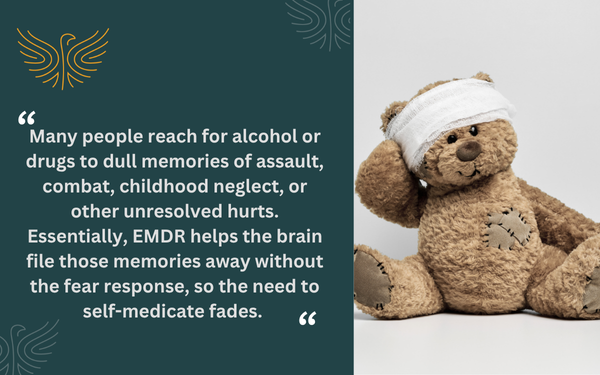Facing addiction can feel like fighting a battle on multiple fronts—physical urges, emotional pain, and memories that refuse to stay in the past. Yet, Eye Movement Desensitization and Reprocessing (EMDR) offers a research-backed way to ease that burden.
Originally developed to treat trauma, EMDR is now helping people rebuild healthier relationships with both their memories and their sobriety. In this article, we explore how EMDR works and how it can help support addiction recovery.
_______________________________________________________
What is EMDR?
Eye Movement Desensitization and Reprocessing (EMDR) is a research-supported therapy that helps the brain “re-file” painful memories so they no longer take over your present moment. Developed by psychologist Francine Shapiro, EMDR combines brief bursts of focused recall with gentle left-right stimulation—usually the therapist’s moving fingers, alternating sounds, or handheld tappers. While the eyes (or ears or hands) follow that rhythmic pattern, the distress linked to the memory steadily subsides.
EMDR unfolds across eight clearly defined phases. After a thorough history and preparation period—where you’ll learn grounding skills for moments of discomfort—you and your therapist choose a target memory, along with the image, body sensation, and self-talk that keep it alive.
Each short set of bilateral stimulation is followed by a pause to notice whatever thoughts or feelings surface. Session by session, the image loses its punch, negative beliefs (“I’m weak,” or “I’ll fail again”) shift, and physical tension eases.
Although EMDR first gained prominence for treating trauma in veterans and survivors of abuse, it’s become a powerful tool in addiction recovery programs. Unresolved trauma often sits beneath cravings, shame, and relapse cycles. By softening the emotional charge around those root memories, EMDR can lower stress reactivity, reduce trigger potency, and free up mental bandwidth for building healthy routines. In short, it helps turn yesterday’s wounds into lessons rather than liabilities—so you can focus on creating a sober, fulfilling future.
_______________________________________________________
The Benefits of EMDR for Addiction Recovery
Eye Movement Desensitization and Reprocessing isn’t just about making painful memories less overwhelming—it can also clear a smoother path to sobriety. By rewiring how the brain stores and responds to traumatic or stressful experiences, EMDR removes the emotional “tripwires” that so often spark craving and relapse. The therapy fits naturally alongside medical detox, counseling, and skills training, offering a mind-body bridge that keeps recovery moving forward. Below are five evidence-informed ways EMDR can strengthen an addiction treatment plan.
1. Reduces Trauma-Driven Cravings
Many people reach for alcohol or drugs to dull memories of assault, combat, childhood neglect, or other unresolved hurts. Essentially, EMDR helps the brain file those memories away without the fear response, so the need to self-medicate fades.

2. Improves Emotional Regulation
Addiction and emotional volatility go hand in hand—anger, anxiety, or shame can spike within seconds and push someone toward substance use.
Yet, EMDR trains the nervous system to tolerate complicated and difficult feelings without becoming overwhelmed. As target memories lose their charge, the amygdala (the brain’s alarm system) quiets down and the prefrontal cortex regains control, making it easier to pause, breathe, and apply the coping strategies learned in therapy groups.
3. Accelerates Progress (When Combined With Other Therapies)
Motivational interviewing, cognitive-behavioral therapy (CBT), and 12-step facilitation all rely on the client’s ability to reflect, learn, and plan. Lingering trauma can block that learning by hijacking attention and energy. But EMDR often removes this obstacle faster than talk therapy alone, allowing clients to engage more deeply in psychoeducation, relapse-prevention planning, and family sessions.
4. Increases Self-Compassion and Motivation
Unprocessed trauma feeds the belief that one is broken, weak, or undeserving of a better life. And these beliefs can sap the will to stay sober, especially when the first slump hits.
EMDR, however, uses positive cognition installation to replace those self-attacks with statements like “I deserve support” or “I have the strength to recover.” As self-talk shifts, motivation becomes intrinsic rather than driven by external pressure, improving adherence to medication schedules and aftercare recommendations.
5. Lowers Your Relapse Risk
Research on veterans, first responders, and survivors of violence shows that EMDR not only reduces post-traumatic symptoms but also maintains those gains months and years later.
In addiction settings, this durability translates into fewer readmissions and longer stretches of continuous sobriety. By dismantling the root stressors that used to trigger substance use, EMDR turns recovery from a daily white-knuckle battle into a sustainable, forward-looking lifestyle—an outcome every client and treatment team strives for.
_______________________________________________________
Taking The First Step Today
Taking the first step toward recovery can feel daunting, but you don’t have to face it alone. Our compassionate team at Freedom Recovery Centers (FRC) is ready to listen, answer your questions, and create a plan that meets your unique needs. Call us at 804-635-3746; our phone lines are open 24/7, so we’re here whenever you’re ready.
.svg)






.svg)

.svg)



.svg)
